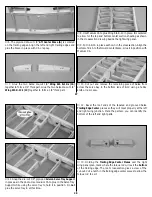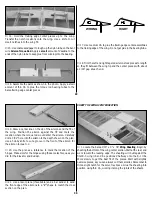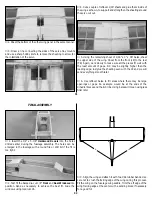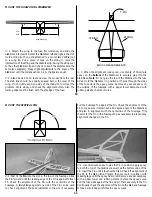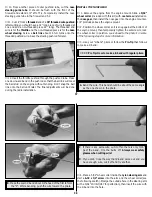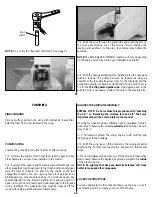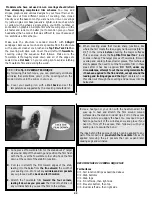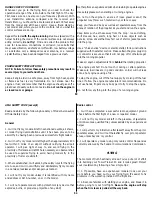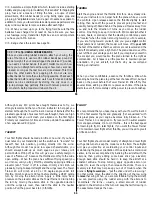
❍
3. Assemble a simple flight kit which should include a starting
battery and glo-plug clip (or ni-starter), "chicken stick" for flipping the
prop, fuel and a means of filling the tank, a couple of small
screwdrivers, #64 rubber bands (or wing bolts), spare prop and
glo-plug, 6" adjustable wrench, and a pair of needle nose pliers. In
addition to tools, you should also take along some paper towels and
spray window cleaner to remove residue after each flight.
❍
4. When you load up to go to the flying field be sure that the
batteries have charged for at least 14 hours. Be sure you have
your fuselage, wing, transmitter, flight box and, most important,
you have your AMA license.
❍
5. Range check the radio! See page 53.
TAXIING
Start the engine and set the throttle trim for a slow, steady idle.
Have your instructor or a helper hold the plane while you work
the controls. Upon release advance the throttle slightly to start
rolling, then back-off the power to prevent going too fast and
possibly taking off. Stand behind the plane as it taxies away from
you and note the direction it turns as you move the rudder
control. One thing to keep in mind with R/C models (whether it
be cars, boats, or planes) is that the steering controls may seem
to "reverse" when the model is moving toward you. For example,
if you are flying toward yourself, and you give a right control
input (ailerons or rudder), the model will move off to your left.
The fact of the matter is that the controls are not reversed and the
aircraft did actually enter a right turn. The plane does move off to
your left from your vantage point, but if you imagined yourself in
the cockpit you would realize the plane turned to the right as
commanded. All it takes is a little practice to maintain proper
orientation of your aircraft, but that's why we recommend
finding an instructor.
When you feel comfortable, advance the throttle a little while
standing behind the plane to get the feel of a takeoff roll, but pull
back on the power before the Tower Trainer 40 lifts off. Try this
several times, adding a little more power each time. If the plane
starts to veer off, immediately cut the power to prevent a mishap.
★★★★
Pro Tip: USING RUBBER BANDS
Since you are using rubber bands to attach your wing, the
rule of thumb is to use two #64 rubber bands per pound of
model weight. If your model tipped the scales at 7 pounds,
you need 14 rubber bands. It doesn't matter too much how
many you run straight across the wing or how many are criss-
crossed, so long as the last two are criss-crossed. This trick
stops the other bands from popping off. Do not use oily
rubber bands for more than a few flying sessions. Check each
rubber band before using it and watch out for cracks. Rubber
bands can be conditioned by storing the oily ones in a
zip-top storage bag partially filled with talcum powder or
corn starch. Both products will absorb the oil.
55
Although many R/C pilots have taught themselves to fly, we
strongly recommend that you find an instructor to help get you
started. Although the Tower Trainer 40 series of trainers offer the
greatest opportunity of success for the self-taught, there is a high
probability that you will crash your airplane on the first flight.
Protect your investment of time and money–obtain the assistance
of an experienced R/C pilot.
TAKEOFF
Your first flights should be made in little or no wind. If you have
dual rates on your transmitter, set the switches to "low rate" for
takeoff. Taxi into position, pointing directly into the wind.
Although this model has good low speed characteristics, you
should always build up as much speed as your runway will
permit before lifting off, as this will give you a safety margin in
case of a "flame-out." Advance the throttle smoothly to the wide
open setting. When the plane has sufficient flying speed (you
won't know until you try), lift off by smoothly applying a little up
elevator (don't "force" it off to a steep climb!), and climb out
gradually, trying to keep it straight and the wings level. The Tower
Trainer 40 will climb at a 20 or 30 degree angle under full
throttle. Climb to about 100 feet before starting a VERY gentle
turn by moving the aileron stick. Apply a little more back
pressure on the elevator stick as the Tower Trainer 40 turns. Stop
the turn by moving the aileron stick in the opposite direction
until the wings are level, then return the stick to the neutral
position. Pull the power back to 1/3 throttle.
FLIGHT
We recommend that you take it easy with your Tower Trainer 40
for the first several flights and gradually "get acquainted" with
this great plane as your engine becomes fully broken-in. The
Tower Trainer 40 is designed to fly level with neutral elevator
trim at approximately 1/4 to 1/3 throttle – this is the best speed
for learning to fly. On later flights, if you want the Tower Trainer
40 to maintain level flight at full throttle, you will need to give it
a little down trim.
Your first flights should consist mostly of straight and level flight
with gentle turns to keep the model over the field. These flights
will give you practice at coordinating your control inputs and
maintaining the proper orientation of the airplane. As mentioned
earlier, turns are accomplished by banking the aircraft with the
ailerons, then gently adding some back stick (up elevator).
Enough back stick should be held in to keep the aircraft at a
constant altitude. To stop turning, apply opposite aileron (or
rudder) to level the wings, then release the sticks. There is a
memory aid that may help keep you out of trouble when the
plane is flying toward you – "put the stick under the low wing."
In other words, move the stick in the direction of the low wing
to raise that wing. When you are comfortable flying the aircraft,
you can practice using the rudder along with the ailerons to
'coordinate' the turns – usually, a small amount of rudder
applied in the direction of the turn will keep the tail following in
the exact same track as the nose.
56

